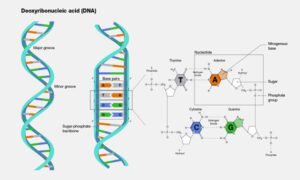Doctor Curmudgeon® Hey There! Did You Forget Somebody?
By Diane Batshaw Eisman, M.D. FAAP Doctor Eisman is in Family Practice in Aventura, Florida with her partner, Dr. Eugene Eisman, an internist/cardiologist
When I think of DNA, the next two words that emerge from my cluttered mind are Watson…Crick.
What is DNA? Wikipedia says it better:
“DNA, short for deoxyribonucleic acid, is the molecule that contains the genetic code of organisms. This includes animals, plant, protists, archae and bacteria. It is made up of two polynucleotide chains in a double helix.
DNA is in each cell in the organism and tells cells what proteins to make.”
DNA, this amazing double-stranded molecule, coiling around itself, can actually make copies of itself and carry genetic information. It is a manual for how to make the proteins in our bodies.
DNA is inherited from parent to child.
In 1869, Friedrich Miescher was looking at white blood cells when he was able to isolate a brand new molecule that he called “nuclein” from the nucleus of a cell. This was DNA.
Somewhere around the end of the 1940s, researchers began to have the glimmer of a radical idea. It had been thought that the molecules that were responsible for our heredity were proteins. But studies began to creep into research papers, hinting that it was likely that it was DNA that actually held the “secret of life.”
But if this were true, what did it look like? What was the structure of this thought to be simple molecule?
Well, as fascinating tales do, good fortune appeared in the form of a British chemist and x ray crystallographer by the name of Rosalind Elsie Franklin.
She has often been referred to as the “dark lady of DNA.” It was Dr. Franklin who made it possible for Francis Crick and James Watkins to delineate the structure of DNA.
Watson and Crick were able to figure out the structure because another colleague, Maurice Wilkins, had the idea to use Franklin’s work in crystallography to see what this molecule looked like.
Evidence had been abounding that it wasn’t the protein in chromosomes that was responsible for what we inherited, it was this DNA.
And it was time to look at this molecule that was the basis of heredity.
Dr. Franklin was involved with diffraction work in London at King’s College. She had published a photo which became famous as “Photo 51.” This showed the double-helix structure of deoxyribonucleic acid.
Using this photo, Watson and Crick were able to create their model of the structure of DNA.
And so, in 1952, Watson, Crick and Wilkins shared in the Nobel Prize in Physiology or Medicine, awarded for their work in 1953 which determined the structure of DNA.
But what of Rosalind Franklin?. It was her crystallographic evidence of DNA’s structure that led to Watson and Crick’s work. And it was her colleague, Maurice Wilkins, who showed “Photo 51” To Watson and Crick. This photo led them to create a molecular model which was consistent with DNA’s physical and chemical properties.
Dr. Franklin had not given permission for Wilkins to show her photograph; it was done without her knowledge.
Her contribution to the understanding of DNA has been unrecognized. And she has been referred to as the “Sylvia Plath of molecular biology.”
Finally, from Wikipedia: “In April 2023, scientists, based on new evidence, concluded that Rosalind Franklin was a contributor and ‘equal player’ in the discovery process of DNA, rather than otherwise, as may have been presented subsequently after the time of the discovery.”
Dr. Curmudgeon suggests “Bitter Medicine”, Dr. Eugene Eisman’s story of his experiences–from the humorous to the intense—as a young army doctor serving in the Vietnam War.
Bitter Medicine by Eugene H. Eisman, M.D. –on Amazon
Doctor Curmudgeon® is Diane Batshaw Eisman, M.D., a physician-satirist. This column originally appeared on SERMO, the leading global social network for doctors.
SERMO www.sermo.com
Click Here to Order Boxing Interviews Of A Lifetime By “Bad” Brad Berkwitt


